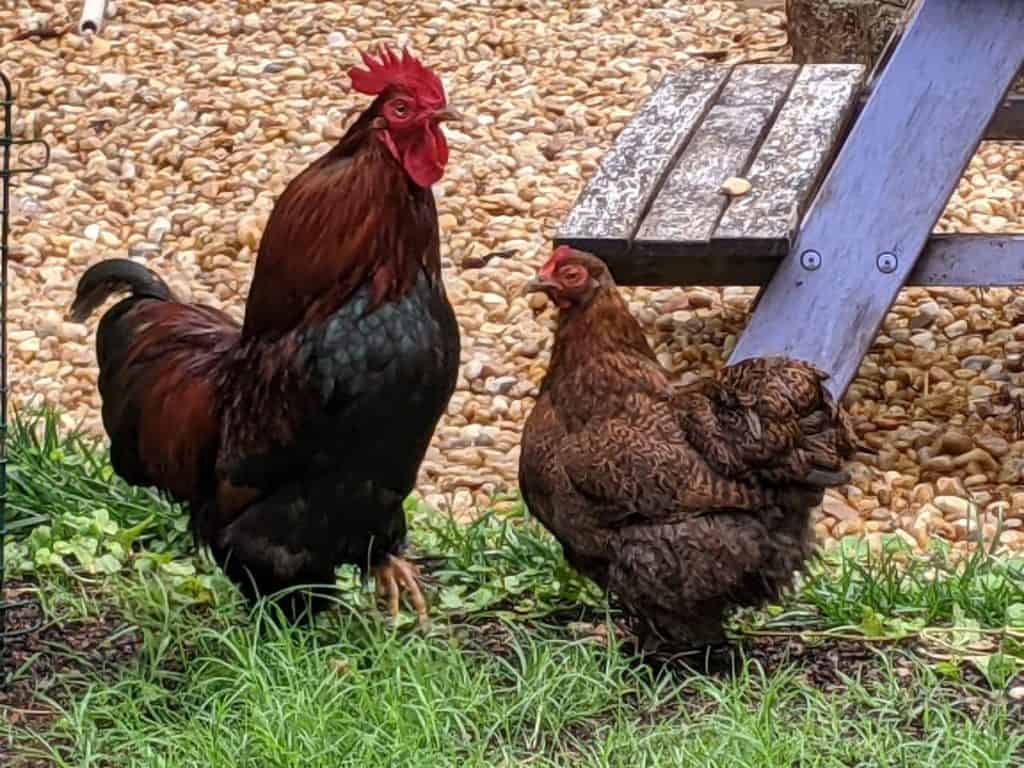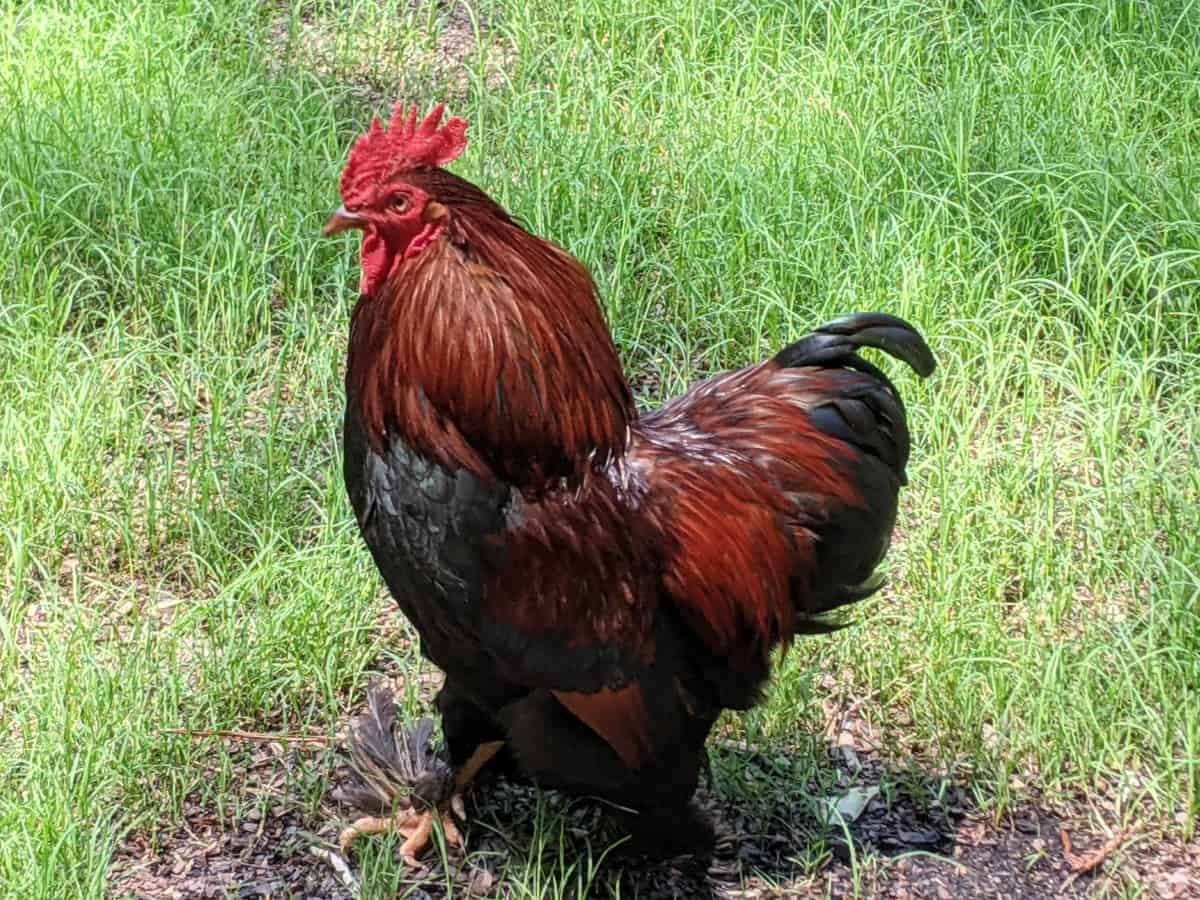When you wake up one morning to find your rooster perched on top of the roof, the only reasonable explanation might be that he flew up there. As amusing as it might sound, the bird surely didn’t climb up there. If we join the belief that chickens can’t fly, how in the world did that happen?
Roosters can fly, but not for prolonged periods of time, and need a running take off to get airborne for short periods. Their body mass, large flight muscles, and short wingspan prohibit them from taking flight in some cases or staying airborne in others.
Roosters are generally bigger than hens which nudges them further into the “flightless bird” category.
Whether you are simply curious about the rooster’s – and by extension the chicken’s – ability to fly, or if you are new to keeping chickens and need some advice on keeping your birds from escaping their enclosure, there are a couple of fascinating things you need to know about how your rooster got on top of the roof.

Do Roosters fly?
Roosters can fly, especially off of something, but they are better at jumping. Some hens and other breeds can fly much better than roosters. Roosters are typically larger than hens; this size difference significantly impacts how well chickens fly in general. Think about eagles or flamingos; these large birds have magnificent wingspans which allow them to carry their bodies’ weight. Roosters have smaller wings, and this prevents them from flying in the same way other birds can. LiveScience explains it with the help of mathematics.
It might sound counterintuitive, but the chicken’s large flight muscles impede its flight. In order to fly, birds need appropriate “wing loading” — a ratio of body mass to wing area. Birds need to have at least 1 square inch of wing per 0.6 ounces of body mass (1 square centimeter per 2.5 grams) to fly.
Roosters jump
Perhaps the real answer of how your rooster ended up on the roof: he probably used his wings, jumping ability, and good old opportunity. A rooster can generally get over a four-foot enclosure or higher if they have help along the way.
If you have something like a large crate near the structure, they may use these as “ladders” to get where they want to go. It may be unlikely that the rooster flew up on the roof in one go.
However, their wings aren’t entirely useless, and they use them for various reasons such as jumping, balancing, and increasing speed while running. Roosters will also use their wings for communication, whether it is to look more threatening or in attempts to seduce a few hens.
Chickens are curious creatures, and they’ll attempt daring escapes to explore the world around them. They might take flight over the fence just for some adventure. In other cases, something can cause them to dart over the fence out of fear. The chicken can become disoriented and might not find its way back home.

Can some breeds fly better than others?
There are a few breeds that you need to keep an eye on when it comes to flying. If you want to keep track of these breeds, a high fence might not do much to keep them from flying around or over the run; clipping their flight feathers can be helpful to limit their chances of getting over the boundary. But it is no guarantee. Chickens that can fly reasonably well include:
- Bantam hens
- Appenzeller
- Red Ranger
- Ancona and Leghorn
- Sumatra
Breeds primarily used for meat production, broiler species such as Cornish Crosses and Jersey Giants, will mostly stay grounded due to their weight. The selective breeding of chickens is what gives them sturdy bodies and inept wings.
Selective breeding for more meat on the bones
In an interview with LiveScience, Michael Habib, an assistant professor at the University of Southern California working in clinical cell and neurobiology, explained why selective breeding resulted in near-flightless chickens.
He referred to the jungle fowl as the immediate ancestor of chickens. These birds, like many other game birds, can only fly for short distances. Through selective breeding, chickens are even less adept at flying than their ancestors.
Habib explained that chickens have big flight muscles, and this is precisely what humans are looking for when breeding birds as food sources: bigger muscles equal more meat. But it also means that these birds are too heavy to take flight or fly for some distance. It is for this reason that roosters can be kept in with a sufficient height barrier.
Lifting or moving the fence to limit their movement
If your fence is too low, roosters and hens might get over the boundary with little effort. Reasons to keep them inside the run can range from protecting them from predators to protecting your neighbors’ green grass. Whatever your circumstances may warrant, you’ll probably go through a series of trials and errors.
Heavier birds might not be a problem, but they will use an opportunity when they get it. Trees or any type of elevated surface near the fence will make their “wall jumping” a competitive sport in no time at all. You will need a secured run of about six feet for roosters and probably higher for hens or other flighty chicken breeds.
Methods to prevent flying (if at all necessary)
If lifting the fence is not an option, or if your birds have hatched a new escape plan, you can either clip their wings or use a method called brailing. Brailing is used to prevent the rooster or hen from unfurling the wing – use this method when clipping the wings is not an option.
With both ways, you should take care not to cause harm to the animal. Usually, this might not be necessary with roosters if your fence is high enough to contain them.
Trimming
Your first thought might be that this might hurt the chicken, but it should not be painful if you do not do it correctly. For prevention, clipping only one of the primary flight feathers should be enough to keep your rooster where it belongs. Trimming just one wing results in an uneven balance, and the bird will – in most cases – not be able to fly.
You can clip both wings if needed. Keep in mind that feathers grow in the same way as hair and nails, so you will have to trim the new feathers that grow out. See the video below on how to do this correctly.
Brailing
You can use this technique when you do not wish to trim the flight feathers. It works almost in the same way as clipping the feathers, especially for a quick solution that you can undo at any time. The flight feathers of one wing are bound with a soft cord – not tightly, as it may restrict blood flow – this is very useful if you only need to keep them grounded for a short period.
If the grounding period extends into week two, remove the cord to give the wing some relief, and secure the flight feathers of the other wing. This method has risks involved if you do it incorrectly and should never be a permanent solution. Read the following article to make sure you don’t cause harm to your bird.
If you decide to clip or bind their wings, keep in mind that you’ll have to make sure they are safe from predators. Roosters use their wings to get away from danger, and if predators can get in, your bird might be left without a way to jump or fly to safety.
Conclusion
You might not see a rooster soaring high above your head anytime soon, but you’ll find that they can still manage to end up in places you didn’t think was possible. If your feathery friends are found outside their enclosure more often than not, you can either attempt to lift the fence or clip their wings to thwart any escape plans while keeping their safety in mind.

